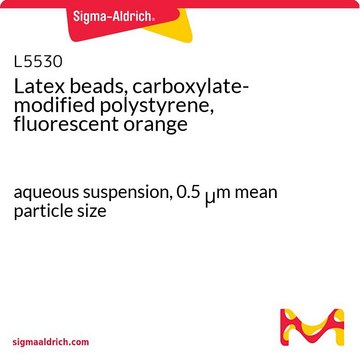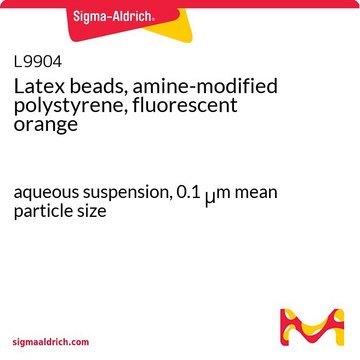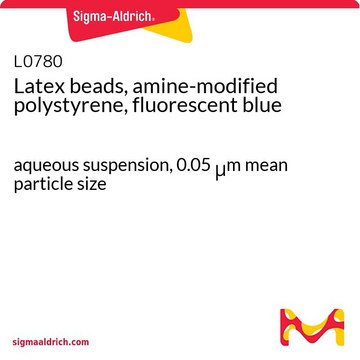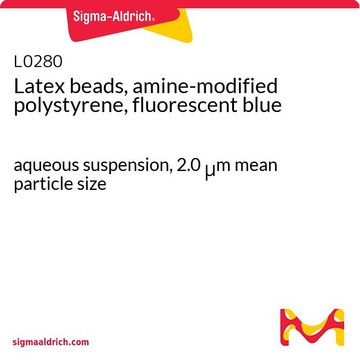LB3
Latex beads, polystyrene
0.3 μm mean particle size
Synonym(s):
Latex Microspheres, Polystyrene Beads, Polystyrene Latex Particles
Sign Into View Organizational & Contract Pricing
All Photos(1)
About This Item
Recommended Products
form
aqueous suspension
composition
Solids, 10%
packaging
pack of 1 mL
pack of 15 mL
pack of 2 mL
mean particle size
0.3 μm
Looking for similar products? Visit Product Comparison Guide
General description
Polystyrene microparticles are stabilized colloidal particles that are anionic. They are producedby the polymerization of styrene under conditions that induce spontaneouscoalescent bead formation. Latex particles are ideal for phagocytosisexperiments, antibody-mediated agglutination diagnostics, electron microscopy,and cell counter calibration.
Application
Polystyrene latex beads have been used:
- in latex particle recovery and size distribution studies
- as a component of the colloidal suspensions for light extinction spectroscopy
- in the quantification of microvesicles by high-sensitivity flow cytometry
Storage Class Code
10 - Combustible liquids
WGK
WGK 3
Flash Point(F)
Not applicable
Flash Point(C)
Not applicable
Certificates of Analysis (COA)
Search for Certificates of Analysis (COA) by entering the products Lot/Batch Number. Lot and Batch Numbers can be found on a product’s label following the words ‘Lot’ or ‘Batch’.
Already Own This Product?
Find documentation for the products that you have recently purchased in the Document Library.
Customers Also Viewed
Light extinction spectroscopy applied to polystyrene colloids: Sensitivity to complex refractive index uncertainties and to noise
Eneren P, et al.
Journal of Quantitative Spectroscopy & Radiative Transfer, 261, 107494-107494 (2021)
Richard Ortega et al.
Particle and fibre toxicology, 11, 14-14 (2014-03-29)
The mechanisms of toxicity of metal oxide particles towards lung cells are far from being understood. In particular, the relative contribution of intracellular particulate versus solubilized fractions is rarely considered as it is very challenging to assess, especially for low-solubility
Chiara Uboldi et al.
Particle and fibre toxicology, 13, 5-5 (2016-02-05)
Poorly soluble cobalt (II, III) oxide particles (Co3O4P) are believed to induce in vitro cytotoxic effects via a Trojan-horse mechanism. Once internalized into lysosomal and acidic intracellular compartments, Co3O4P slowly release a low amount of cobalt ions (Co(2+)) that impair
Yu Chen et al.
Journal of biophotonics, 10(11), 1411-1420 (2017-04-19)
Optical coherence microscopy (OCM) has unique advantages of non-invasive 3D imaging without the need of exogenous labels for studying biological samples. However, the imaging depth of this technique is limited by the tradeoff between the depth of focus (DOF) and
Joanna Koziel et al.
PloS one, 4(4), e5210-e5210 (2009-04-22)
It is becoming increasingly apparent that Staphylococcus aureus are able to survive engulfment by macrophages, and that the intracellular environment of these host cells, which is essential to innate host defenses against invading microorganisms, may in fact provide a refuge
Our team of scientists has experience in all areas of research including Life Science, Material Science, Chemical Synthesis, Chromatography, Analytical and many others.
Contact Technical Service








